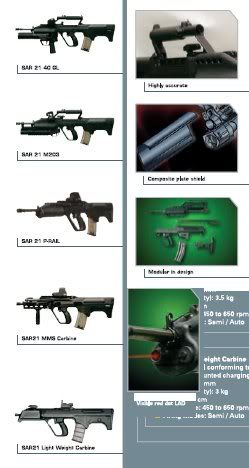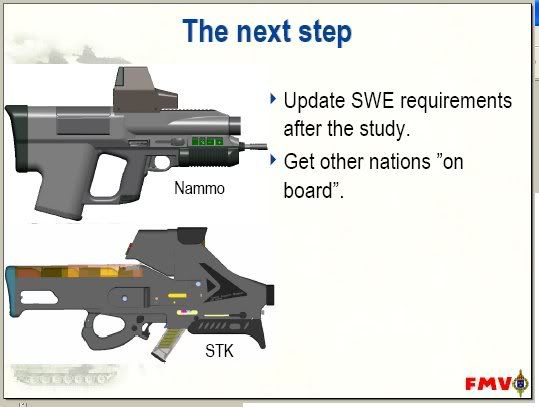In a move that could reverse years of Army small arms policy, the
service is asking industry to send in ideas for a new combat rifle that
could replace the M4 carbine.
In late August, the Army issued a solicitation to the arms industry
asking companies to submit proposals that would demonstrate
"improvements in individual weapon performance in the areas of accuracy
and dispersion ... reliability and durability in all environments,
modularity and terminal performance."
And in a dramatic gesture that could throw the door wide open to a
totally new carbine, the service did not constrain ideas to the current
5.56mm round used in the M4.
"We're at the point now where we're going to go out and compete," said
Richard Audette, project manager for Soldier weapons at the Army's
Picatinny Arsenal.
"We're looking for anyone that has a world-class carbine," Audette told
Military.com in a Sept 15 interview. "We're interested in any new
technologies out there."
Audette couldn't remember an Army weapons program that opened up the
competition to ideas so diverse; he cited the M240 request in the 1990s
and M9 solicitation in the 1980s as examples of broad requests, but
they stuck with specific caliber ammunition.
The Army's abrupt change in direction -- after long stating it would
stick with the M4 until there was a "leap" in technology that would far
surpass current carbine performance -- comes after nearly two years of
pressure on the service to re-examine the M4 and entertain a
nearer-term replacement.
Some in Congress have called for the Army to hold a "shoot-off" with
several other carbine designs alongside the Colt-built M4 to
demonstrate the state of the art in today's military arms market. Sen.
Tom Coburn (R - Okla.) briefly held up the nomination of Army Secretary
Pete Geren in mid-2007 to force the service into side-by-side
comparisons of M4 competitors in extreme dust conditions.
Many argue the M4 is more susceptible to fouling due to its
gas-operated design, and say other systems are less maintenance
intensive.
The move to broaden the competition is also calendar-driven: the
so-called "technical data package" of the M4 -- essentially the
blueprints for the design -- are up for release in June of next year.
That means the Army can rebid the M4 to any company that can make it,
potentially driving down costs and boosting production capacity.
And as if that wasn't enough, the Army is also in the midst of
re-writing its carbine requirements document, which will spell out
specifically what the service needs for its primary weapon. Audette
said the ideas sent in as a result of his solicitation will help inform
officials at Training and Doctrine Command as they update the Army's
carbine plan.
"If there's some new technology out there, they want to be able to
write a requirement that will not limit the Army to something they
could possibly have," Audette said.
The Army is leaving itself open to carbine ideas that could stray from
the nearly 40-year policy of using 5.56mm ammunition for its rifles.
Recent developments in ammunition calibers have bolstered critics who
contend the 5.56 round has too little "stopping power" and passes
through its target without incapacitating him.
Army officials have repeatedly stated that knockdown has as much to do
with marksmanship as ballistics, arguing that if you shoot more
accurately, you'll drop your target on the first shot.
But several "boutique" rounds have been making inroads with weapons
developers both in and outside the government. The 6.8mm and 6.5mm
round are increasingly popular, as is the old-school 7.62mm round --
which Special Operations Command plans to incorporate into its new
carbine program.
"We want to know about everything that's out there, regardless of
caliber," Audette said. "If you've got a 6.8, we're interested in that
and seeing what that brings to the table."
The solicitation also asks for ideas on a "subcompact" weapon that
Audette says should basically be a smaller version of the carbine; this
one would be more suitable for vehicle crewmen and aviators, who have
to maneuver the weapon in confined spaces but don't need the same range
capability that a foot Soldier would.
The Army wants to know about production quantity, asking industry in
the late-August solicitation to submit information on "minimum and
maximum monthly production rates" for their carbine and subcompact
guns. Currently, Colt can churn out as many as 10,000 M4s per month.
"We don't want to spend 20 years producing 1,000 carbines per month,"
Audette said. "If we choose a new carbine we want to have a production
capacity in place so that we can ramp up and get a lot of these out the
door."
Industry sources say the Army solicitation isn't just smoke and mirrors
to satisfy critics of the M4. They say a competition will likely occur
next summer between different weapons and the best gun will win.
If that does happen, Soldiers -- and potentially their counterparts in
the other services -- won't likely see their new carbines until 2012,
after all the testing and evaluation is done. The Army currently has a
requirement for 450,000 M4s, though that number could climb if the
service decides to replace all M-16s with the smaller M4, Audette said.
©
Copyright 2008 Military.com.
All rights reserved. This material may not be published, broadcast, rewritten or redistributed.





















